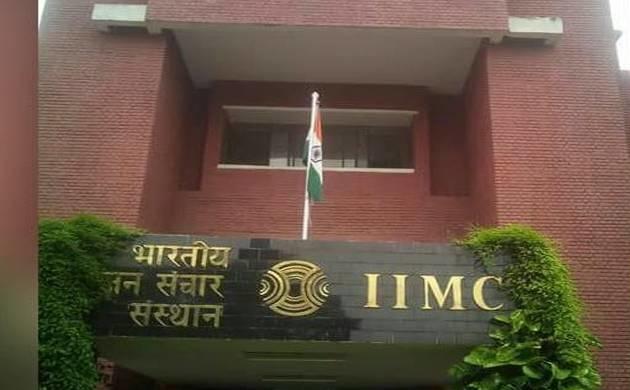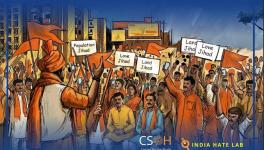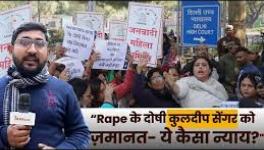Meet Members of Indian Institute of Mass Communication’s New Executive Council

The Indian Institute of Mass Communication (IIMC), one of the premier media studies institute in the country, has been the target of saffron eyes -- the Sangh Parivar and its political arm, the Bharatiya Janata Party (BJP)-led government. It is an autonomous society under the Ministry of Information and Broadcasting (I&B).
IIMC’s new Executive Council (EC), which is to meet this Wednesday, has on board Hitesh Shankar, editor Panchajanya, a Rashtriya Swayamsevak Sangh (RSS) mouthpiece; Rakesh Khar, editor, special projects, Network 18, Smita Prakash, editor, ANI and senior journalist MD Nalapat. The EC is responsible for taking decisions related to administration, budget and infrastructure. It has a fixed tenure of two years and also takes the final call on decisions related to budgetary allocations before it is presented to Parliament. The EC has a secretary of the I&B Ministry as chairperson and it is the I&B ministry that chooses the members of the Council.
There has been widespread criticism from domain experts that IIMC, just like other educational institutions in the country since the Narendra Modi-led BJP government came to power in the Centre in 2014, is being filled with ‘mediocre’ faculty and administration. Some appointments made by the Modi government, such as Vice-Chancellors of central universities like Jawaharlal Nehru University and heads of prestigious research institutes like the Indian Council of Historical Research, Indian Institute of Advanced Study at Shimla, Banaras Hindu University, Film and Television Institute of India (FTII) are cited as some examples of mediocrity that the BJP is promoting.
After 2014, while key posts in premier educational institutes were placed with those who adhered to the philosophies of the Sangh Parivar and BJP, the media, especially TV channels, was completely co-opted. As soon as the BJP came to power, as Nalpat himself has written, the same media which “spew venom” at Modi started to worship him and his government. News in the mainstream, especially the vernacular, media now is overwhelmingly dominated by fake news. Amidst the growth of fake news and continuous attack on freedom of the media, there exist alternate news portals that are registering dissent of various communities in the country. But, IIMC’s new EC member Hitesh Shankar, as discussed, feels the alternate media is not worthwhile.
Also Read: Reflections on Emergency and Press Censorship Today
The new EC of IIMC is a story of the project of Sangh Parivar and BJP, which aims in producing docile minds that won’t dissent. If Shankar, who is the editor of a publication of Sangh Parivar, is a direct give away of this project, the trajectory of Khar, Prakash and Nalpat tells us that not speaking against and questioning this government is a qualification that the current government looks for in its appointments.
In this context, the new EC surely has its task cut out in helping the government churn out ‘saffron-friendly’ young journalists. Here’s a peek into the ‘significance’ of IIMC’s new EC in the BJP/RSS political game plan in the media world and the saffron view of what and ‘ideal’ media should look like. Now let us look at the new EC of the institute, which will be meeting here Wednesday, as per a report in Hindustan Times.
The New EC and the Saffron regime
Hitesh Shankar, editor of Panchajanya, in one of his articles writes, “even though Dolphins are few in number they are amazing and most intelligent of all the marine life. The nature of Dolphin is better suited to media than that of Sharks and Carps.”
Defining how the media should function, Shankar draws obscure analogy of different kinds of fish. In this analogy, the alternate online media is like carp fish because they are large in number and are found globally. He writes, “The millions of internet media portals are like the carp fish. You will find that they serve as food for most of the larger fishes. Jo bikega wahi dikhega- sankhya aur sansani...lagta hai ki in dino Bharatiya carp media ne isiko apna mantra bana liya hei.” (That which is seen, will sell. Looks like the Indian carp media’s motto is -- numbers and sensationalism.)
Also Read: Nexus Between Media and Right Wing Uncovered: Cobrapost Investigation Exposes Media Bigwigs
Shankar concludes in his article on what media in the country should be like, saying, “Dolphins are quiet and intelligent in an ocean full of marine life. They are always ready to learn new things and successfully replicate what they learn. They learn from their mistakes and do what they are told is right and are also favourites of the crowds. Why can’t media take on this role?” The editor of RSS’s mouthpiece himself clarifies what the Sangh Parivar wants the media to be -- a puppet or dolphin in the hands of the establishment.
The Sangh Parivar and BJP have always considered media as an important tool to influence viewers with their ideology. A recent sting operation on various media houses by investigative website Cobrapost is a testimony for this.
Appointments made to the EC by the BJP government, therefore, are similar to those in other educational institutions, as late columnist Praful Bidwai wrote, and will serve to reflect its own specific brand of “cultural nationalism” by engineering long-term changes in programmes and priorities.
Also watch: Cobrapost Expose: How Corrupt is the Indian Media?
The Modi government is the favourite and the best government that the country has ever had, for both Rakesh Khar and Smita Prakash. The articles published in media platforms that they work for and their blogs and Twitter account bear testimony to their cheerleading the Modi government.
In 2015, just a year after the Modi government came to power, artistes spearheaded a movement against growing intolerance in the country and attack on freedom of expression. They returned the awards they received by the Government. What should have been an embarrassment for a ruling government, gave rise to pro-government protests and discourses. Khar in one of his articles for Network18 writes, “As celebrities get more than their due share of headlines wading into the ever raging tolerance versus intolerance debate, a sad and tragic episode of intolerance towards socio-economic challenges in mega metros is causing undue fatalities and irreversible damage to core values that define India.”
Khar further talks about an unfortunate death of a 38-year-old techie who succumbed to heart attack and says, “Far removed from the celebrity ire over issue of perceived intolerance lies the sordid tale of youngsters pressing the escape route to redeem themselves from the pressures of managing a difficult life in mega metros of India.”
It is not to say the issue that he is raising should not be spoken about or written about, but one wonders, how are the two issues connected? A look at his work establishes his pro-establishment stance on several issues.
Smita Prakash is one of the very few journalists who was lucky enough to get a chance to interview the Prime Minister. This 70-minute interview for ANI was to answer all the critics of the government and was called, “Will Modi Silence all his Critics?”. It concluded with an emotional Prime Minister defending himself against his critics based on his silence during the 2002 Gujarat riots. Prakash is also a member of the controversial new eight-member Central Press Accreditation Committee constituted by the government, which was criticised by senior journalists for having only "people close to the government" in it.
Nalapat, who also is an academic, writing for Sunday Gaurdian, a few days ago, defended the Modi government against the criticism of communalism that the government has met with in the last five years. He writes, “the Narendra Modi government has followed a hyper-cautious policy towards the past that has done little to lower the sense of insecurity and injustice prevalent in the Hindu psyche as a consequence of decades of “Nehruvian secularism”. This, by definition, posits that only Hindus are “communal” and every other community “secular”, no matter how extreme their views. An abortive UPA-era legislation sought to anchor this tenet even more firmly than before, explicitly implying that only Hindus would be found guilty in communal incidents.”
He goes on to say, “98% of Hindus and Muslims are moderate, and to ensure that this percentage does not dip in future, a gesture of divine benevolence on the part of the Muslim community needs to be taken to ensure that the Ram Janmabhumi, the Krishna Janmabhumi and the ancient Kashi Viswanath temple in Varanasi be restored to the condition they were in before the Mughals... The atmosphere of love and trust that will get created between Hindus and Muslims after the handover of these three shrines will ensure that such fringe moves get treated with derision. Any attempt by elements of the Hindu fringe to take over any other place of worship (once the three mentioned above have been restored) should be met and thwarted with armed force by the state.” One wonders if this language is any different from the language lately of the Sangh Parivar in relation to these shrines?
Get the latest reports & analysis with people's perspective on Protests, movements & deep analytical videos, discussions of the current affairs in your Telegram app. Subscribe to NewsClick's Telegram channel & get Real-Time updates on stories, as they get published on our website.























